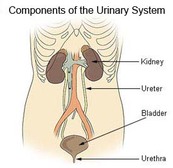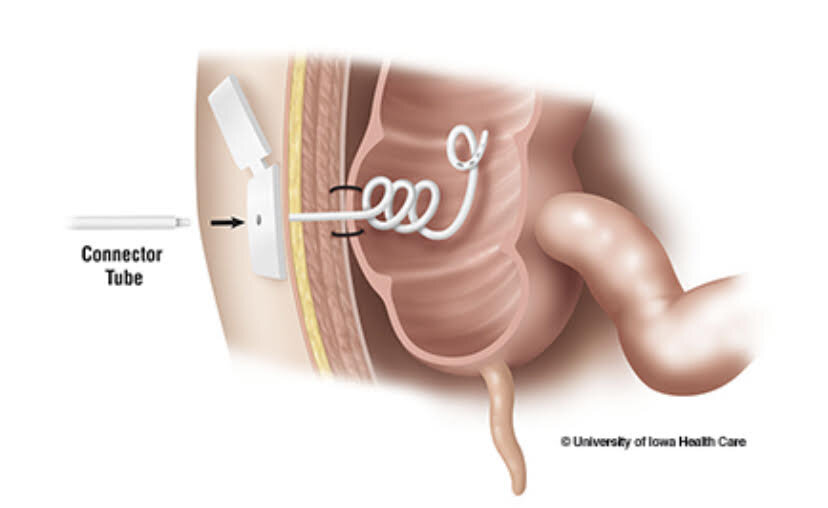Urostomy
Urostomy surgery becomes necessary when the bladder stops working properly. There are many reasons; a few are because of bladder cancer, a spinal cord injury or a birth defect.
Urine is waste produced from your blood due to the filtering function performed by your kidneys. Everything that is left over after purification such as salts, urea, toxins and surplus water becomes urine that moves down to your bladder. Peeing removes these wastes.
Image courtesy of US Dep't of Health SEER Urinary System
Diagrams & text both above and below used with permission from the Canadian Association of Enterstomal Therapy (CAET), 2015
The urinary tract consists of two kidneys, two ureters, one bladder and one urethra (Diagram #1). Urine is made in the kidneys and flows through the ureters into the bladder, where it is stored. The bladder is a soft balloon-type organ that stretches as urine fills it and contracts when it is emptied. The urethra is the tube that drains urine from the bladder to the outside of the body.
A urostomy is a surgically created opening to divert urine from its normal route. This surgery is necessary when the bladder must be removed or bypassed. Children who have urinary tract birth defects may need a temporary urostomy.
Urostomies are usually permanent for adults. Common reasons for performing urostomies in adults include: cancer of the bladder, spinal cord injury resulting in loss of bladder control, and neuromuscular diseases such as multiple sclerosis.
The most common type of urostomy is called an ileal conduit. To create the conduit, the surgeon isolates a short piece (about 10 cm) of small intestine (bowel) (Diagram #2). The small intestine is reconnected and functions normally.
The piece of isolated bowel is closed at one end. The other end is brought to the outside of the abdomen, turned back on itself like a cuff of a sleeve creating the stoma and sewn to the skin. The ureters from the kidneys are attached into this piece of small bowel, which is now called the conduit (Diagram #3).
The part of the small intestine known as the ileum is used to make the conduit; therefore, the urostomy is called an ileal conduit (Diagrams #2 and #3). The urine is excreted from the kidneys and drains through the ureters into the conduit. From the conduit the urine drains through the stoma. The ileal conduit is not a storage cavity and urine drains most of the time. A pouch must be worn at all times to collect the urine.
Cecostomy
A cecostomy is a tube placed into the body near the Cecum, at the beginning of the large intestine. There is an exterior component and an interior component. The tube is used to assist in evacuating the bowels of stool/poop and for maintaining continence during the day. Typically, it is placed when there is no disease in the bowel, but the body can not achieve continence. For a MACE, the tube stays in the body and is not removed. For a Chait or Mic-Key tube, it needs to be changed with a new tube on a basis provided by the doctor, but otherwise does not come out.
Chait
Once the cecostomy is placed and the site is healed, the person will irrigate the bowel using the tube. This may be called a “flush” or a “routine”. An enema/laxative is brought to the bowel via the cecostomy and extensions added. The doctor will go through the particular substances and measurements, as well as length of the routine, at some point during the initial implantation.
Most common reasons for getting a cecostomy are Spina Bifida, the person is born with an imperforate anus, and other muscular abnormalities.
There are two main types. A MACE, also called a Malone, has a “bubble” at the end of the interior portion of the tube. It is slightly larger than a chait. A Chait has a trapdoor device on the exterior and a curled tube inside.
Resources
An excellent “everything” guide: A Guide to Living with an Ileal Conduit
ConvaTec Canada The basics - Urostomy Surgery (Excellent illustration and description of an ileal coduit)
Coloplast – What is a Urostomy
Coloplast: Urostomy Guide to Living Well
The UK Urostomy Association
Ostomy Care Canada: Understanding Your Urostomy
UOAA: Living with a Urostomy
Coloplast: Life after Urostomy
Bladder & Bowel Community: How Having a Urostomy Improved My Life
American College of Surgeons - Emptying your Urostomy Pouch
https://www.youtube.com/watch?v=0o55KfNNw2w
American College of Surgeons - Changing your Urostomy Pouch
https://www.youtube.com/watch?v=qRmUOlCgigg
MACE





